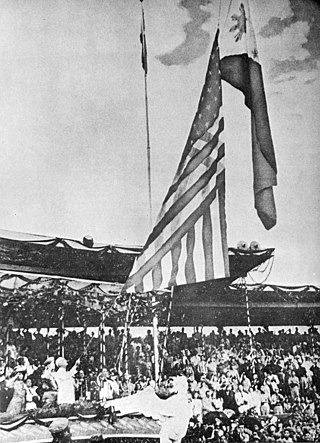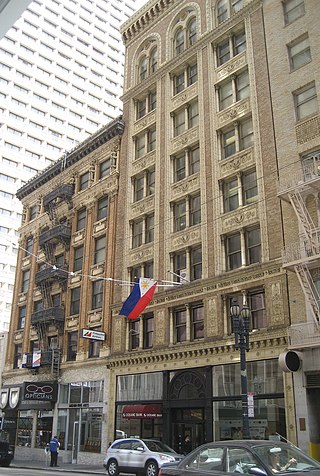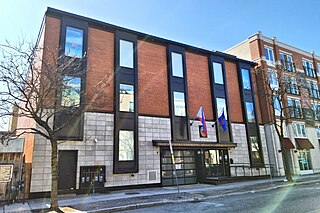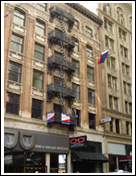
Malacañang Palace, officially known as Malacañan Palace, is the official residence and principal workplace of the president of the Philippines. It is located in the Manila district of San Miguel, along Jose P. Laurel Street though it is commonly associated with Mendiola Street nearby. The term Malacañang is often used as a metonym for the president, their advisers, and the Office of the President of the Philippines. The sprawling Malacañang Palace complex includes numerous mansions and office buildings designed and built largely in the bahay na bato and neoclassical styles. Among the presidents of the present Fifth Republic, only Gloria Macapagal Arroyo actually lived in the main palace as both her office and her residence, with all others residing in nearby properties that form part of the larger palace complex. The palace has been seized several times as a result of protests starting with the People Power Revolution of 1986, the 1989 coup attempt, the 2001 Manila riots, and the EDSA III riots.

Philippine Republic Day, also known as Philippine–American Friendship Day, is a commemoration in the Philippines held annually on July 4. It was formerly an official holiday designated as Independence Day, celebrating the signing of the Treaty of Manila, which granted Philippine independence from the United States of America in 1946.
José Tanig Joya was a Filipino abstract artist and a National Artist of the Philippines awardee. Joya was a printmaker, painter, mixed media artist, and former dean of the University of the Philippines' College of Fine Arts. He pioneered abstract expressionism in the Philippines. His canvases were characterized by "dynamic spontaneity" and "quick gestures" in action painting. He is the creator of compositions that were described as "vigorous compositions" of heavy impastoes, bold brushstrokes, controlled dips, and diagonal swipes". Joya added the brilliant tropical colors. He was awarded a grant, which enabled him to pursue a master's degree in Fine Arts in 1956–57. His works were strongly influenced by the tropical landscapes of the Philippine Islands. Among his masterpieces are the jedree (a collage rendered with Asian calligraphy and forms and patterns resembling rice paddies), the Granadean Arabesque (1958) and Biennial (1964)

The Emilio Aguinaldo Shrine is a national shrine located in Kawit, Cavite in the Philippines, where the Philippine Declaration of Independence from Spain was declared on June 12, 1898 or Independence Day, To commemorate the event, now known as Araw ng Kalayaan or Independence Day, a national holiday, the Philippine flag is raised here by top government officials on June 12 each year. The house is now a museum.
Ang Kiukok was a Filipino painter of Chinese descent and was a National Artist for Visual Arts.

Vicente Silva Manansala was a Filipino cubist painter and illustrator. One of the first Abstractionists on the Philippine art scene Vicente Manansala is also credited with bridging the gap between the city and the suburbs, between the rural and cosmopolitan ways of life. His paintings depict a nation in transition, an allusion to the new culture brought by the Americans. Manansala together with Fabian de la Rosa are among the best-selling Philippine artists in the West.

José Veloso Abueva was a Filipino political scientist and public administration scholar who served as the 16th president of the University of the Philippines. A Ten Outstanding Young Men (TOYM) awardee for political science in 1962, he has devoted much of his career in academic circles. He has been faculty member of the National College of Public Administration and Governance of the University of the Philippines Diliman and visiting professor at Brooklyn College, City University of New York and Yale University. He has also worked with the United Nations University in Tokyo. Abueva's service to the nation includes stints as secretary of the 1971 Constitutional Convention, executive director of the Legislative-Executive Local Government Reform Commission and Chairman of the Legislative-Executive Council that drew up the conversion program for former military bases. Abueva wrote a number of books, including Focus in the Barrio: The Foundation of the Philippine Community Development Program and Ang Filipino sa Siglo 21. Among the publications he has edited is the 20-volume PAMANA: The UP Anthology of Filipino Socio-Political Thought since 1872.
Michael Dadap is a popular Filipino guitarist, composer, and conductor, and an influential advocate of Filipino folk music. He was influential in the creation of a world-class rondalla ensemble in the United States is also the founding music director of the Iskwelahang Rondalla of Boston, Massachusetts.
Hernando Ruiz Ocampo was a Filipino National Artist in the visual arts. He is also fictionist, a playwright and editor.

Arturo Rogerio Dimayuga Luz was a Filipino visual artist. He was also a known printmaker, sculptor, designer and art administrator.

Mario Parial was a multi-awarded Filipino painter, printmaker, sculptor and photographer. His works have been sold at Sotheby's.
Philippine News Agency (PNA) is the official news agency of the Philippine government. PNA is under the supervision and control of the News and Information Bureau, an attached agency of the Presidential Communications Operations Office. It was established on March 1, 1973, by President Ferdinand Marcos, and currently has its headquarters in Quezon City.

The Chapel of San Lorenzo Ruiz was a Catholic church in the Archdiocese of New York, located at 378 Broome Street between Mulberry and Mott Streets in the Nolita neighborhood of Manhattan in New York City. The chapel was established in 2005. The building was originally constructed for the Church of the Most Holy Crucifix in 1925–26, and was designed by Robert J. Reiley.

The Consulate General of the Philippines in San Francisco is a foreign mission of the Republic of the Philippines in the United States, representing the country's interests in northern California, the Pacific Northwest, the Rocky Mountains, and Alaska. It is located at the Philippine Center at 447 Sutter Street in Downtown San Francisco, just north of Union Square.

The Consulate General of the Philippines in Los Angeles is a diplomatic mission of the Republic of the Philippines in the United States, representing the country's interests in southern California. It is located on the fifth floor of the Equitable Life Building at 3435 Wilshire Boulevard in the Koreatown neighborhood of central Los Angeles, a couple of blocks north of the Robert F. Kennedy Community Schools.

The Embassy of the Philippines in Ottawa is the diplomatic mission of the Republic of the Philippines to Canada. Opened in 1971, it is currently located at 30 Murray Street in the ByWard Market neighborhood of central Ottawa, roughly between the U.S. and Danish embassies.

The Embassy of the Philippines in Kuala Lumpur is the diplomatic mission of the Republic of the Philippines to Malaysia. It is at 1 Jalan Changkat Kia Peng in central Kuala Lumpur, near significant city landmarks like the Kuala Lumpur City Centre and Bukit Bintang.

The Consulate General of the Philippines in Honolulu is a diplomatic mission of the Republic of the Philippines in the United States, representing the country's interests in Hawaii. Opened in 1946, it is located along Hawaii Route 61 in the Nuʻuanu neighborhood of northern Honolulu, next to the campus of the Hawaii Baptist Academy.

The Consulate General of the Philippines in Chicago is a diplomatic mission of the Republic of the Philippines in the United States, representing the country's interests in the state of Illinois. Opened in 1948, it is currently located on the 16th floor of the Peoples Gas Building in the Historic Michigan Boulevard District, part of the Loop community area in downtown Chicago, across from the Art Institute of Chicago.




















